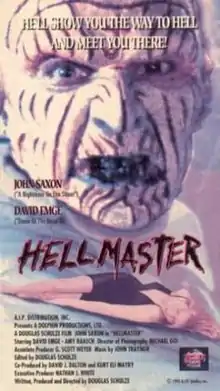Hellmaster
Hellmaster (also known as Soulstealer)[1] is a 1992 American horror film written and directed by Douglas Shulze, and starring John Saxon. The plot follows a psychotic college professor who uses unsuspecting students as laboratory rats, injecting them with a drug that mutates them into brutal killers.[2]
| Hellmaster | |
|---|---|
 VHS cover | |
| Directed by | Douglas Schulze |
| Produced by | David J. Dalton Kurt Eli Mayry Douglas Schulze |
| Written by | Douglas Shulze |
| Starring | John Saxon David Emge Amy Raasch Edward Stevens |
| Cinematography | Michael Goi |
| Edited by | Sean Hoessli |
| Distributed by | Dolphin Productions[1] |
Release date | December 16, 1992 |
Running time | 92 minutes |
| Country | United States |
| Language | English |
Plot
Part of a secret government eugenics project, crazed biochemistry professor Jones (John Saxon) committed terrible crimes on his college campus in the late 1960s before one of his colleagues burned the college to put a deadly end to his spree. Jones is presumed dead, but a series of murders twenty years later raises questions of whether he has somehow managed to return. In actuality, Jones's drug experiments have turned him into a superhuman. Having teleported himself to safety during the fire, he has been living underground continuing his experiments. With an injection, he is able to turn people into mutants who will follow his will. With the help of his zombie-like army, Jones plans to access his stores of his "Nietzsche Drug" in the catacombs beneath the campus. Standing against him are three people: a psychic, a reporter and a woman who has already survived one supernatural attack. The psychic determines that she herself must take the Nietzsche Drug so she can face the mad professor and his mutant slaves.[3][4]
Cast
- John Saxon as Professor Jones
- David Emge as Reporter
- Jeff Rector as Jesse
- Amy Raasch as Shelley
- Edward Stevens as Drake
- Sean Sweeney as Joel
- Melissa Zafarana as Tracy
- Jim Riethmiller as Harrold
- Sarah Barkoff as Little Girl
Home media
The film was released on DVD on September 19, 2006 and includes audio commentary from director Shulze and one of the producers, along with a conceptual art gallery, and a behind-the-scenes gallery.[5]
References
- Kuehls, David (October 1991). "Soulstealer: The Doctor is Insane". Fangoria. No. 107. Starlog Group, Inc. Retrieved July 2, 2018.
- Hellmaster (1992)
- allmovie ((( Hellmaster > Overview )))
- Hellmaster
- allmovie ((( Hellmaster [Unrated Director's Cut] > Overview )))